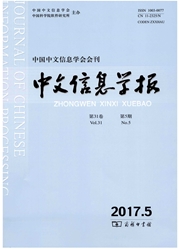

 中文摘要:
中文摘要:
组块分析的主要任务是语块的识别和划分,它使句法分析的任务在某种程度上得到简化。针对长句子组块分析所遇到的困难,该文提出了一种基于分治策略的组块分析方法。该方法的基本思想是首先对句子进行最长名词短语识别,根据识别的结果,将句子分解为最长名词短语部分和句子框架部分;然后,针对不同的分析单元选用不同的模型加以分析,再将分析结果进行组合,完成整个组块分析过程。该方法将整句分解为更小的组块分析单元,降低了句子的复杂度。通过在宾州中文树库CTB4数据集上的实验结果显示,各种组块识别结果平均F1值结果为91.79%,优于目前其他的组块分析方法。
 英文摘要:
英文摘要:
Chunking ipcludes identification and labeling of chunks, which is a way to reduce the difficulty of complete syntactic parsing through segmenting a sentence into small chunking parts. In order to reduce the complexity of long sentence chunking, a divide-and-conquer strategy is described in this paper. The basic idea of this method is to first recognize the maximal noun phrases (MNP) form a full sentence; then identify the chunks within the MNPs and a- mong the frame of the sentence without MNPs ~. Experiments are carried out on the data set of UPenn Chinese Treebank-4 (CTB4) and the results show the the best of overall F1 score of Chinese chunking is 91. 79%, which is higher than the performance produced by the state-of-the-art machine learning models.
 同期刊论文项目
同期刊论文项目
 同项目期刊论文
同项目期刊论文
 期刊信息
期刊信息
